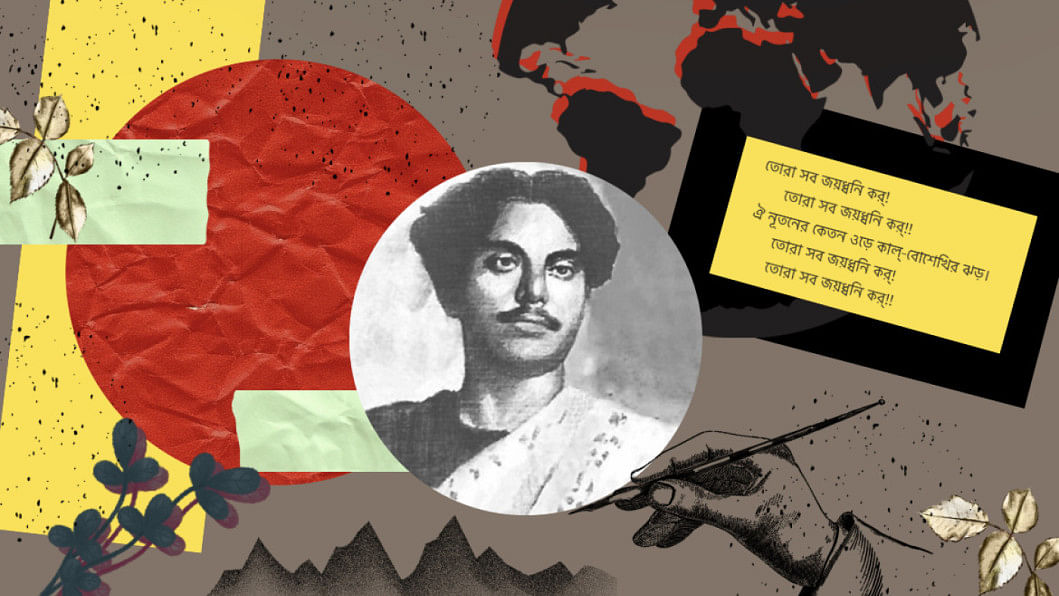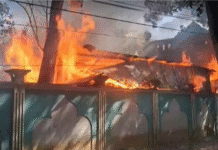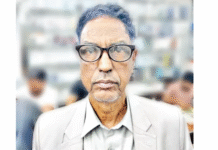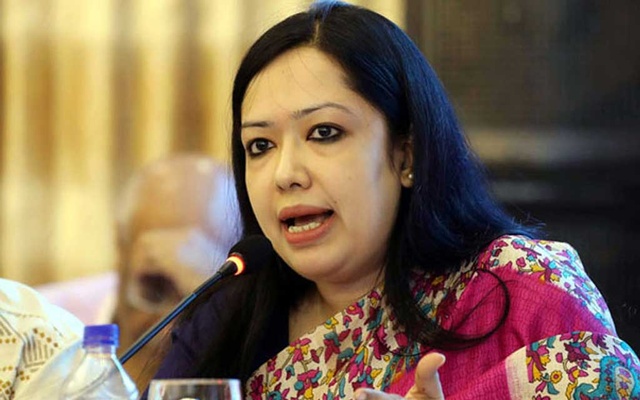
Last update on: Sun May 25, 2025 10:00 AM

Born in 1899, national poet Kazi Nazrul Islam, also known as the rebel poet, brought a bold new voice to Bangla literature and national life. His poetry fiercely challenged injustice and inspired youth towards positive change. Early in his career, Nazrul addressed themes of human-caused planetary crisis, making him a pioneer in environmental reflection in the Bangla language. As a visionary, he foresaw both life’s vitality and the world’s potential destruction.
After military service, Nazrul returned to Kolkata, writing poetry and stories, and joined a circle of progressive writers and activists. His friendship with Muzaffar Ahmad marked a key turning point in his life and work. They launched the evening daily Nabajug on July 12, 1920, with support from political leader AK Fazlul Huq, as a form of both resistance to colonial rule and political activism.
Nabajug was crucial to Nazrul’s early career, providing him with a platform to write on politics and literature. Printed on a single sheet and sold for one paisa, it quickly gained a wide readership despite the founders’ limited journalistic experience. Nazrul’s talent for succinctly summarising complex news impressed his colleagues and contributed to the paper’s success. It was in Nabajug that Nazrul published Roz-Kiyamat (translated as Doomsday by Arka Dev), an article symbolising the planetary crisis.
What truly set Nabajug apart, however, were Nazrul’s innovative headlines. Drawing from his deep familiarity with Bangla literary traditions, he infused his headlines with references from the poetry of Chandidas and Vidyapati, and even quoted Rabindranath Tagore. In one notable instance, he borrowed and modified two verses of a Tagore song to title a report on Faisal, the emperor of Iraq.
Beyond his reporting on Iraq, Nazrul and his associates developed a distinctly internationalist outlook. Their writings reflected a deep interest in anti-colonial struggles worldwide and strong solidarity with the growing labour and communist movements.
In his article Roz-Kiyamat, Nazrul cited several esteemed scientists who had claimed that the day of the Earth’s destruction was not as far off as many had long supposed. Drawing from their findings, he noted that over the past 50 years, the number of icebergs in the southern polar region had steadily increased. Captain Smitharth of Edmonton was the first to discover a 580-foot-high iceberg, followed by Captain Scott, who observed an ice shelf towering over 600 feet.
He wrote that a sailor from Egeneta had seen a mountain-like iceberg over a thousand feet high—a sight that shocked the entire world. It was later confirmed that this ice mountain was 1,612 feet thick—nearly a quarter to half a mile wide. Around the Antarctic Circle, the number of massive icebergs and ice shelves was steadily increasing. This, he argued, was causing the southern polar region to warm at an alarming rate. As a result, the northward-drifting icebergs were bringing extreme winters to South Africa and South America.
Nazrul Islam, though young as an editor, was wise in his thinking. By translating the findings of Professor Louis and other renowned scientists for the Bangalee audience, he warned that the second great flood—or the great extinction—was imminent on Earth. While the entire planet might not be destroyed, it was beyond doubt that a significant part of it would be devastated.
In his article, he wrote of an immense expanse of sky-reaching ice shelves in the South Pole—14 miles long and hundreds of miles thick. With the climate there growing steadily warmer, he posed a striking question: what would be the consequence of this? “Everyone knows that ice melts when heated,” he warned. As temperatures rose, he reported thousands of kilotons of icebergs and shelves breaking apart and melting—streams and glaciers surging forward like sky-high, mobile Himalayas, destined to wash away everything in their path. One might think this came from a modern scientific or journalistic report, yet it was written in 1920 and published in the book Jugabani in 1922. The book was immediately banned.
He observed that humanity was increasingly dependent on coal mining and its widespread use for energy. “Do you know which era this coal dates back to?” he asked. “It comes from the carbonic acid-saturated ages, many hundreds of thousands of years ago, formed from the trees of that era. Even today, forest vegetation remains adept at absorbing carbonic acid. Yet every bit of coal, every matchstick burned, consumes the very oxygen essential to human survival.” He cited a renowned English scientist who had recently warned that atmospheric oxygen was steadily decreasing, leading to pollution and a gradual return to the carbonic acid-filled conditions of prehistoric times.
Nazrul was acutely aware of the environmental hazards posed by coal. He warned that even if humanity stopped its reckless exploitation of this destructive fuel—noting that, even at the time he was writing, burning coal consumed over 1,600 million tons of oxygen annually—and turned to electricity as an alternative, new dangers would inevitably emerge. “Whichever path we choose, death awaits—crocodiles in the water, tigers on land!” he wrote, voicing his scepticism about electricity as a truly safer substitute. His words reflect a remarkably early awareness of the environmental trade-offs of industrial progress, articulated in the Bangla language over a century ago with striking foresight.
Globally, discussions of climate change began to surface in the 1960s, initially gaining traction in the Western world before spreading more broadly. In this context, Kazi Nazrul Islam stands out as a pioneer in alerting Bangalee readers to planetary crises long before the concept was widely recognised. Through his journalistic writings—often adopting a pessimistic tone that contrasts with his usual celebration of youth and life—Nazrul depicted the harsh realities of environmental degradation. Though writing nearly a century ago, his work captured the destructive nature of climate change, offering a prophetic glimpse into the global crisis that would unfold in the decades to come.
Priyam Paul is a journalist and translator.
Views expressed in this article are the author’s own.









